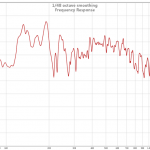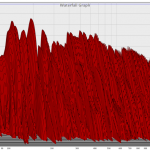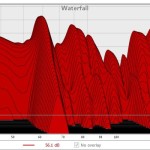How Many Desibles Are Art and Sound Water Speaker
Decay time waterfall graphs and frequency response charts are tools to measure the acoustics of a room. This article looks to demystify and explicate what these graphs and charts actually mean.
Most of u.s. accept seen frequency response charts before – perhaps when looking to purchase a new microphone or a new set of speakers. But anyone that has listened to many speakers can tell you that the frequency response pictured in your manual or on the back of your speakers never really gives you lot much of an idea on what the speaker sounds like. Similarly, viewing the measured frequency response of a room doesn't tell you much about how the room sounds. When someone suggests a room sounds "boomy", "weak", "indigestible", "reverberant", "expressionless", or "alive" – they aren't referring to the frequency response of the room, but instead referring to the decay times in the room. "Decay times" are a measure of the time sound takes to diminsh at different frequencies. Looking at waterfall graphs (or other similar graphs) can requite you a much better idea of what the room actually sounds and feels similar than frequency response lone, and tin give you a great insight on what you need to treat the room.


The Waterfall Graph gives united states more information than Frequency Response Nautical chart.
Disuse times show usa what happens in what we call the "fourth dimension domain" – simply put: decay times illustrate what sound does in a room after the initial audio is played from speakers. Certain bass problems in a room like room modes and standing waves cause certain bass notes to resonate or "ring out" in a room. In other words, the sound is even so nowadays in the room fifty-fifty after the speakers stopped producing it. In a typical room, multiple bass notes volition resonate past a half second. There are like high frequency issues in rooms also, like palpitate echo. Palpitate repeat is that annoying "ping" that yous can hear when you clap your hands, and it is present anywhere at that place are two parallel hard surfaces. A clap is quite a brusk sound, but the echoes stay in the room for a much longer period. Flutter echo and room modes are both examples of problems that happen in the time domain, and we can examine their furnishings with waterfall graphs.
We mentioned the terms some people utilize to depict a room similar "expressionless" or "boomy", merely what do these terms hateful? Untreated or improperly treated rooms have longer disuse times at certain places, and shorter decay times at others. Imbalances of these decay times can sound strange and uncomfortable. For instance, a room with long disuse times in the bass range can sound "muddy" or "boomy." Instead of hearing the bass for what it is, it just sounds as if the bass is wet with reverb, making different notes smear together. Dirty rooms make it difficult to distinguish notes conspicuously. Take a await at the disuse fourth dimension of a room that is treated with carpet, blankets, or foam on the wall. Treatments like these shorten the disuse times of treble just, leaving us with imbalanced disuse times, furthering usa from an accurate and comfortable room. Rooms where the high end dies out quickly are usually noted every bit sounding "dead" or "muffled".
Controlling decay times is important for anyone interested in improving their room acoustics. In a home theater setting, controlling decay times is of import for clarity of dialogue, clearing up the low end to requite your sub more touch, and alleviating localization problems common with surroundings sound systems. In a ii-channel listening room (or any general listening space), decision-making disuse times is important for bringing out the exact sound of your speakers, so you can hear the reverb that was recorded with the crisp hiss of a ride cymbal or the torso of a resonant cello with the least amount of artifacts from the room. In broadcast and instruction, speech intelligibility is extremely important. The reverb of a large hall, the resonation of a pocket-sized recording area, or the flutter echo in a classroom are all damaging to song frequencies and demand to be controlled for articulate and concise speeches, lectures, and interviews. Audio engineers in control rooms and mail-production rooms need to be able to hear the sounds, instruments, and vocals they are mixing clearly. Without controlling decay times, it is easy to over- and under-compensate with compression, EQ, effects, and end with a production that just doesn't interpret well to other systems. Recording engineers know they have to tape the exact sound they want on the record, which needs to be free of any unwanted reflections and resonances.
Listen to the recorded audio of two different songs in the same room, each recorded once before handling and once after treatment. Sound comparison of untreated and treated room. Notice how the long decay times effect the clarity of the low-, mid- and upper- frequencies.
There are many types of acoustic treatments, and they all bear upon decay times differently. Broadband absorbers like our GIK 242 Acoustic Panel, GIK 244 Bass Trap, GIK Monster Bass Trap, GIK Tri-Trap Corner Bass Trap©, and GIK Soffit Bass Trap© work over a broad range of frequencies and will reduce decay times from bass up through to the treble range. Thicker broadband panels will piece of work to a lower frequency. If wide control is needed, simply the high range doesn't need as much absorption, the GIK Scatter Plate can be added onto most of our broadband absorbers to reflect & scatter hi-mids and treble, giving yous further control of your decay times. Tuned bass traps, similar our GIK Scopus Tuned Bass Traps, tin can be used to reduce decay times of specific frequencies, so we tin dampen any specific modes and resonances without affecting the rest of the room.
The post-obit waterfall graphs illustrate disuse times of a room before and after treatment.


Diffusors serve a different function than absorbers, but their use tin notwithstanding chronicle to decay times. Flutter echo and other harmful reflections need to be dealt with, merely in some rooms absorption would make decay times further imbalanced. Diffusors allow reflections to exist spread out with very trivial to no absorption, meaning nosotros can accomplish controlled acoustics while preserving disuse times from mids and upwards.
In full general, frequency response can give us some clues, like nulls that need to be dealt with, merely decay time graphs give us a much meliorate view into the room and the problems that need to exist addressed. Controlling decay times are of import for any room to be comfortable and workable. Many GIK Acoustics products were designed with the importance of decay time control in heed, and are tested to ensure yous know exactly where they perform best.
At GIK Acoustics, nosotros strive to bring solutions for whatever room while meeting all of your needs and preferences at an unbeatable price. Consummate our Audio-visual Advice form for complimentary personalized recommendations for your room today!
Source: https://www.gikacoustics.com/understanding-decay-times/
0 Response to "How Many Desibles Are Art and Sound Water Speaker"
Postar um comentário